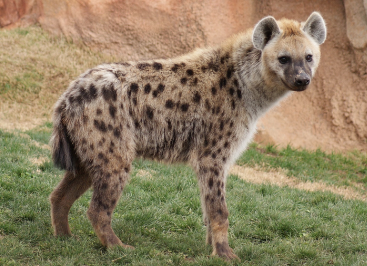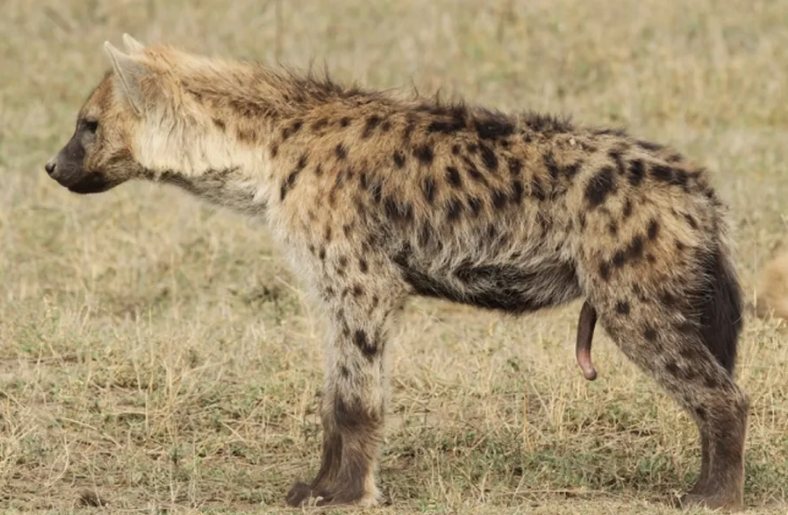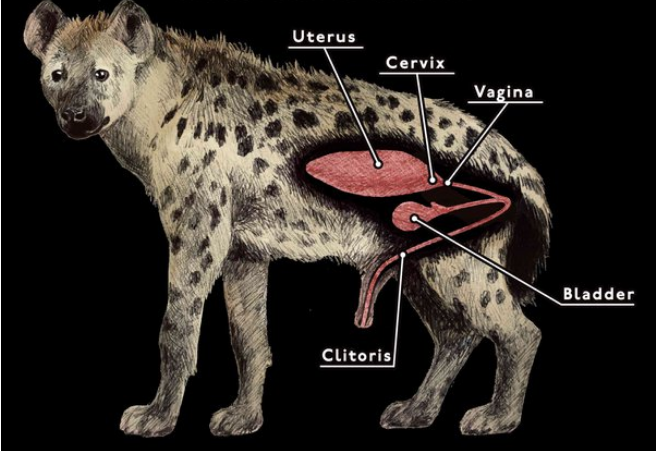Among the four species of hyena, the largest, most widespread and most misconstrued of is the spotted hyena, Crocuta crocuta. With its scrappy fur, hunched back and wide, drooling grin.
In a surprising twist of nature, female hyenas possess a pseudo-penis that is remarkably similar in size and appearance to the male’s actual penis. This similarity has led to confusion and misconceptions about hyena reproduction, as it is not immediately obvious which is which. Let’s talk about male and female hyenas at length.
Male Spotted Hyenas
Male spotted hyenas are smaller in size and are less robust build compared to females. Males weigh about 10-15% less than females and have less muscle mass. They can weigh between 40.5–55.0 kg (89.3–121.3 lb).
Male spotted hyenas usually form coalitions with other males, typically siblings or unrelated males who join together for mutual benefits. These coalitions are for purposes of accessing resources such as food and defending territory. Male coalitions can be both competitive and cooperative, depending on the circumstances and available resources.

Male spotted hyenas are known for their vocalizations, which include whoops, giggles, and calls. These vocalizations serve are for maintaining territorial boundaries, coordinating clan activities and reinforcing social bonds within the coalition.
The mating process itself can be complex and challenging for male hyenas due to the similarity in their genitalia with females. The female’s pseudo-penis has a small opening, making mating a physically demanding and prolonged activity.
The male hyenas are integral members of their clans. They engage in roles like patrolling and defending the clan’s territory. Their presence serves as a deterrent to potential threats.
Female spotted hyenas

Female spotted hyenas are larger and more robust than their male counterparts, with an average body weight that can be 10-15% greater. Females weigh 44.5–63.9 kg (98–141 lb).
The distinguishing feature of female spotted hyenas is their external genitalia, which closely resemble an elongated pseudo-penis. This structure is composed of the clitoris and labia, forming a tubular shape that is difficult to distinguish from the male’s genitalia. The pseudo-penis serves multiple functions, including urination, mating and giving birth.
In spotted hyena clans, females dominate, forming matrilineal social structures led by an alpha female. She determines access to resources, including food and breeding opportunities. Males occupy a subordinate position within these clans. However, their roles within the clan are still significant, contributing to clan defense and cohesion.

Reproduction in female spotted hyenas is complex and challenging due to their unique genitalia. Mating involves a careful process where the male must align his genitalia with the female’s pseudo-penis. Copulation is followed by an extended gestation period, lasting around 110 days. The female gives birth through the pseudo-penis, which is often physically demanding.
Female spotted hyenas are skilled hunters and scavengers. Their powerful jaws and teeth are adapted for crushing bones, allowing them to access nutrient-rich marrow. Female hyenas work together in coordinated packs during hunts, which increases their success rate in taking down prey, including large mammals.
Male vs Female Hyenas: Key Differences
| Characteristic | Male Spotted Hyenas | Female Spotted Hyenas |
|---|---|---|
| Physical Size | Larger and heavier, with males weighing 40.5–55.0 kg (89.3–121.3 lb). | Female hyenas are a bit larger than the males. Females weigh 44.5–63.9 kg (98–141 lb). |
| Genitalia | Have a well-developed scrotum and penis | Have a pseudo-penis that is enlarged and resembles the male’s |
| External Reproductive Organs | Penile and testicular | Clitoral and labial |
| Reproductive Role | Limited role in cub rearing | Primary role in cub rearing |
| Aggression and Dominance | Less aggressive and dominant within the clan | More aggressive and assertive within the clan |
| Social Hierarchy | Lower in the clan’s social order | Dominant in the clan’s hierarchy |
| Social Structure | Form smaller, more cohesive coalitions | More solitary |
| Access to Food Resources | Have priority access to carcasses | May have to wait their turn |
| Vocalization | Produce fewer vocalizations | Produce a wide range of vocalizations, including “laughing” calls |
| Role in Hunting | Participate in hunting to some extent | Mainly focus on hunting |
| Communication | Limited communication with clan members | Extensive communication with clan members, including vocalizations |
| Testosterone Levels | Higher testosterone levels | Lower testosterone levels |
| Reproductive Role | Do not engage in nursing young | Give birth and actively nurse and care for offspring |
| Cub Development | Less involved in cub care and protection | Actively participate in maternal care and protection of cubs |
| Clan Size | May form smaller, transient clans | Typically belong to larger, more stable clans |
| Scent Marking | Use anal gland secretions for marking. Less frequent and less intense scent-marking. | Use anal gland and vaginal secretions for marking |
| Cooperation in Social Groups | Form loose, less stable coalitions | Form stable, matriarchal clans |